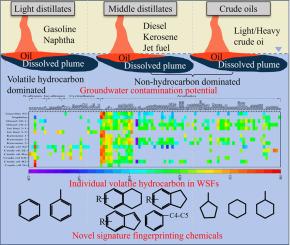Molecular composition of water soluble fraction of petroleum products and crude oils: Insights into groundwater contamination potential and environmental forensics
IF 6.3
2区 环境科学与生态学
Q1 ENVIRONMENTAL SCIENCES
引用次数: 0
Abstract
Petroleum leakage is a major groundwater contamination source, with chemical composition of water soluble fractions (WSFs) from diverse oil sources significantly impacting groundwater quality and source identification. The aim of this study was to assess impact of 15 diverse oils on groundwater quality and environmental forensics based on oil-water equilibrium experiments. Our results indicate that contamination of groundwater by gasoline and naphtha is primarily attributed to volatile hydrocarbons, while pollution from diesel, kerosene, and crude oil is predominantly from non-hydrocarbons. Rapid determination of the extent of non-hydrocarbon pollution in WSFs was achieved through a new quantitative index. Gasoline and naphtha exhibited the highest groundwater contamination potential while kerosene and light crude oils were also likely to cause groundwater contamination. Although volatile hydrocarbons in the WSFs of diesel and jet fuel do not easily exceed current regulatory standards, unregulated non-hydrocarbons may pose a more severe contamination risk to groundwater. Notably, the presence of significant benzene and toluene, hydrogenation and alkylation products (e.g., C4-C5 alkylbenzenes, alkylindenes, alkyltetralins, and dihydro-indenes), cycloalkanes in WSFs can effectively be utilized for preliminary source identification of light distillates, middle distillates, and crude oils, respectively.

石油产品和原油水溶性组分的分子组成:对地下水污染潜力和环境法医学的见解
石油泄漏是地下水污染的主要来源,不同油源的水溶性组分的化学组成对地下水水质和来源识别有重要影响。本研究以油水平衡实验为基础,探讨15种不同油类对地下水水质的影响及环境取证。研究结果表明,汽油和石脑油对地下水的污染主要来自挥发性烃,而柴油、煤油和原油的污染主要来自非烃。通过一种新的定量指标,实现了WSFs中非烃污染程度的快速测定。汽油和石脑油污染地下水的可能性最大,煤油和轻质原油也可能造成地下水污染。虽然柴油和喷气燃料中挥发性碳氢化合物的含量不会轻易超过现行监管标准,但不受监管的非碳氢化合物可能会对地下水造成更严重的污染风险。值得注意的是,WSFs中存在大量的苯和甲苯、加氢和烷基化产物(如C4-C5烷基苯、烷基烯、烷基四苯和二氢茚)、环烷烃,可以有效地分别用于轻质馏分油、中间馏分油和原油的初步来源鉴定。
本文章由计算机程序翻译,如有差异,请以英文原文为准。
求助全文
约1分钟内获得全文
求助全文
来源期刊

Journal of Environmental Sciences-china
环境科学-环境科学
CiteScore
13.70
自引率
0.00%
发文量
6354
审稿时长
2.6 months
期刊介绍:
The Journal of Environmental Sciences is an international journal started in 1989. The journal is devoted to publish original, peer-reviewed research papers on main aspects of environmental sciences, such as environmental chemistry, environmental biology, ecology, geosciences and environmental physics. Appropriate subjects include basic and applied research on atmospheric, terrestrial and aquatic environments, pollution control and abatement technology, conservation of natural resources, environmental health and toxicology. Announcements of international environmental science meetings and other recent information are also included.
 求助内容:
求助内容: 应助结果提醒方式:
应助结果提醒方式:


